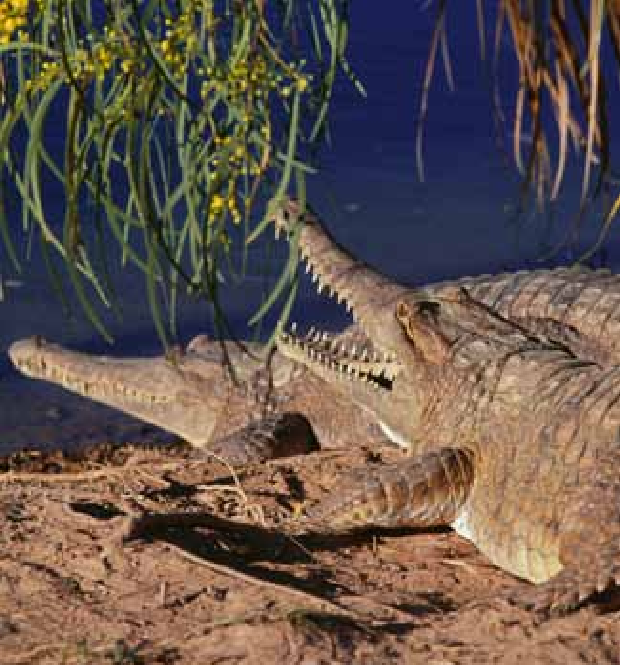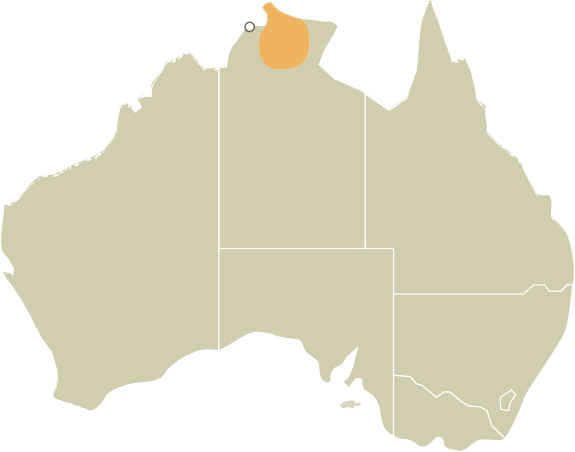Australia's Timeless North
澳大利亚永恒北方之地

Cared for by the world’s oldest living culture for more than 50,000 years, World Heritage- listed Kakadu and surrounds are a place of enormous biodiversity and cultural richness, where 2.5 billion year-old rocks have sculpted savannah woodlands, eucalypt and monsoon forests, rivers and bi I la bongs, coastal beaches, mudflats and mangroves.
About one-quarter of Australia’s land mammals (more than 77 species) live in this rich environment with 271 birds (one-third of Australia’s bird species), 132 reptiles, 27 frogs, 246 fish, almost 1,600 plant species and thousands of insect species.
EXPERIENCE A LIVING CULTURAL LANDSCAPE
Indigenous traditional owners in Australia’s Timeless North have a deep spiritual attachment to the land dating back to the ancestral creation period known as the Dreamtime. One of the main Dreamtime ancestors in Australia’s Timeless North is known as Warramurrungundji (Mother of the Earth). Sending out spiritual children, she taught them which languages to speak and howto hunt and gather food. After creating river systems, billabongs and much of the wildlife in the region, she sat down and rested, changing into a large rock which marks her dreaming site. Cave paintings, rock caves and archaeological sites hidden throughout the rocky landscape document Dreamtime stories like these, creating one of the longest historical records of any group of people in the world.
The cultural obligations and responsibility for country handed down by the ancestors are still central to the lives of Indigenous traditional owners, and age old skills such as patch burning remain integral to modern day land management.
SALTWATER (ESTUARINE) CROCODILES - A CONSERVATION SUCCESS STORY
Crocodiles are a vital part of thefood chain, helpingto maintain the natural balance of wetland ecosystems. Between the 1940s and 1960s, when they were hunted for skins and sport, crocodiles came close to extinction. Populations have recovered since protection in 1971.This is crocodile country’-obey the crocodile warning signs!
STONE COUNTRY
With imposing sandstone walls up to 330 metres high, the Arnhem Plateau dominates the landscape for 500 kilometres. In the wet season, the plateau comes alive with cascading waterfalls as heavy rain tumbles through extensive networks of chasms and gorges. During the dry season, the plateau guards pockets of water in its crevices and cracks, keeping many plants and animals alive until the rains come again.
TIDAL FLATS AND COAST
The rain sweeps nutrient-rich soils down rivertothe expansive tidal mudflats and mangrove forests. Monitor lizards prey on flying foxes fallen from the trees, egrets and cormorants nest in the mangroves and gentle dugong (sea cows) feed on sea grass beds.
SOUTHERN HILLS AND RIDGES
The retreating Arnhem escarpment descends to hills and ridges in the south, exposing ancient volcanic rocks and a large variety of habitats. Here, the striking salmon gum sheds its white barkto reveal to glow a beautiful pink each year. Freshwater crocodiles live in the creeks and pools while the monsoon forests which line the cool, moist gorges are home to the brightly coloured hooded parrot, red goshawk, the endangered Gouldian finch, Calaby's mouse and the Kakadu dunnart.
SAVANNAH WOODLANDS AND LOWLANDS
The lowlands and woodlands with their eucalypts and tall grasses contain a greater variety of plants and animals than any other habitat in Australia's Timeless North. Dusk and dawn see the woodlands burst into a chorus of bird-songfrom red-collared lorikeets, red-winged parrots and sulphur-crested cockatoos. The evening brings the distinctive call of the barking owl, and small nocturnal mammals such asflyingfoxes, phascogales and bandicoots emerge to feed.
澳大利亚永恒北方之地
世界遗产名录中的卡卡杜及其周边地区孕育着世界上最古老的文化,历史可以追溯到5万多年前,生物物种繁多,文化博大精深。此处有疏林林地、桉树林、季雨林、河流、洼地、沿海海滩、泥滩和红树林,其中还矗立着有25亿年历史的岩石。 这个丰富多彩的环境为大约四分之一的澳大利亚陆地哺乳动物(超过77种)、271种鸟类(三分之一的澳大利亚鸟类),132种爬行动物,27种蛙类,246种鱼类,近1,600种植物和数千种昆虫提供了栖居之所。
河漫滩和洼地
潮湿的季节雨水孕育了浅浅的淡水海,绵延数百平方公里。卡卡杜的广阔湿地公认具有国际性重要地位,它吸引了数百万的水鸟,其中包括大群的鹊鹅。 每年雨季洪水泛滥之时,都会有数百万只禽鸟从俄罗斯、中国和日本等地飞来。澳洲鹤在傍晚天空中掠过一道道剪影;白腹海雕盘旋空中,寻找猎物;裸颈鹳搜寻芦苇丛中的蛇类做食物;雉鸻(也称'耶稣'鸟)踮着脚尖,长脚信步穿过一片片莲叶。当洪泛平原逐渐干涸时,植物花朵进入了争相开放的季节,大群野鸭、野鹅和涉水鸟开始涌向河流和洼地区域。
石头之国
阿纳姆高地拥有高达330米的砂岩墙,绵延500公里。在雨季,大雨瓢泼而至,水流在纵横交错的峡谷和山谷之间奔腾,形成了层叠瀑布,高地也焕发出勃勃生机。在旱季,高地的缝隙和裂缝中还储有水源,这为许多动植物的生存提供了保障,帮助它们等待下一次雨季的到来。
潮汐平地和海岸
雨水将营养丰富的土壤冲刷至河流之中,流向广阔的潮汐泥滩和红树林。在这里,巨蜥捕食树上跌落的狐蝠,白鹭和鸬鹚在红树林中筑巢,性情温和的儒艮(海牛)以海草为食。
南麓山区和山脊
阿纳姆悬崖在南部沉降为山丘和山脊,显露出古老的火山岩,成为各种各样动物的栖居地。每年,高大的红皮桉树表面的白色树皮渐渐剥落,露出内部漂亮的亮粉色。淡水鳄生活在小溪和水池中,而鲜艳的黑冠鹦鹉、褐肩鹰、濒危物种七彩文鸟、卡拉比山鼠和卡卡杜袋貂栖居在在凉爽潮湿峡谷的季雨林中。
疏林林地和低洼平地
与澳大利亚永恒北方之地的其他栖息地相比,洼地和林地因为拥有桉树和高草,吸引了更多种类的动植物栖居在此。黄昏和黎明时分,林地中红领彩虹鹦鹉、红翅鹦鹉和葵花鹦鹉的歌唱声不绝于耳。夜晚来临,吠鹰鸮的独特叫声响透夜空,此时还会有一些小型夜行哺乳动物,如狐蝠、袋小鼠和袋貍出来觅食。


